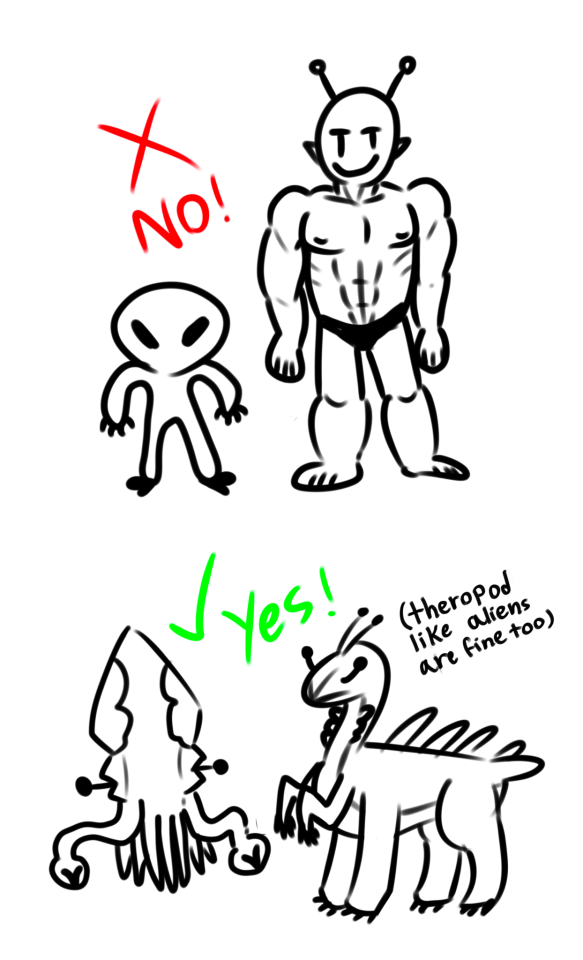Specbio - Tumblr Posts
Ok so, here’s a funky fact: in the early evolution of fish, the claspers (reproductive organs still present in modern sharks) actually began as a genuine third pair of limbs. Sooo what if instead of becoming purely reproductive, the claspers instead developed into full on legs.
Basically what I’m saying here is six-finned fish -> hexapedal early tetrapods -> hexapedal temnospondyls -> hexapodal tiny weirdo arboreal dendrerpetids that develop membranes to glide -> amphibian dragons

they have little grabby hands and spurt venom out of their mouths and they are my precious new babies
Ok so, here’s a funky fact: in the early evolution of fish, the claspers (reproductive organs still present in modern sharks) actually began as a genuine third pair of limbs. Sooo what if instead of becoming purely reproductive, the claspers instead developed into full on legs.
Basically what I’m saying here is six-finned fish -> hexapedal early tetrapods -> hexapedal temnospondyls -> hexapodal tiny weirdo arboreal dendrerpetids that develop membranes to glide -> amphibian dragons

they have little grabby hands and spurt venom out of their mouths and they are my precious new babies
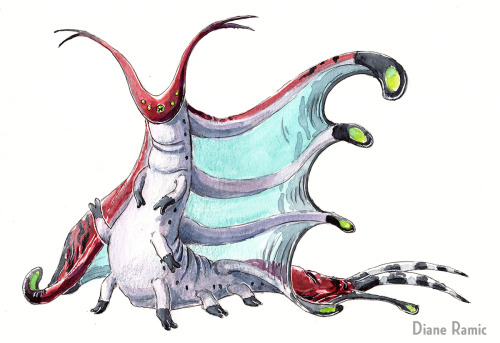
Did a watercolor illustration of a new species I’m working on for a new world! They are called quiverleafs, a name given to these photosynthetic aliens based on the movements they make while communicating via membrane movements underwater. Their sun is a K7-class star, so their “plant” colors would be the red and cyan shown here. The spots of green are reflective, and useful in communication.
Ahh, the seas of Europa. A major topic of debate in the astrobio community. As cool as it would be to imagine giant marine organisms drifting through the European depths, it's probably not the case. If life exists below the surface of Jupiter II, it will probably be fairly small -no more than a meter or two in size- and the reason for that is energy.
Europa, like all planets and moons, is an open energy system, receiving energy from outside the system in various ways. On Earth, the main form of energy input when it comes to the biosphere is sunlight, with some chemical processing taking over in places where the sunlight doesn't reach. The rest of Earth's energy input comes from tidal interaction with the other bodies of the solar system, especially the Moon, which manifests via friction as heat. That heat, as far as we know, is only exploited indirectly by organisms.
Europa, by contrast, gets MOST of its energy from tidal interaction with Jupiter and the other moons in the Jupiter sphere, transforming via friction into heat at its core and convecting up through the crust. Europa gets very little sunlight, and the light it does catch falls on an airless surface separated from the ocean by kilometers of hard ice. Europa actually gets more energy from particle radiation caught in Jupiter's magnetic field than it does from the sun. Overall, the Europan energy system likely has less energy than Earth's, and in different forms.
Europa's ocean is extremely deep, estimated at something like 100 kilometers from the underside of the ice to the rocky crust. While it appears to be rich in various complex life-friendly compounds like salts, tholins, and molecular oxygen, the fact of the matter is that almost all of the water column would be empty space. The likeliest forms of autotroph in Europa would be chemosynths (gaining energy from chemical reactions) and thermosynths (gaining energy from heat gradients). Both of these would probably have to stick to points on the ice subsurface and ocean floor where energy is abundant, like slush zones and geothermal vents, in order to survive. That all said, energy would be hard to distribute, and organisms in environments like that tend to be on the small side. Let's dive into speculation for a bit.
In terms of stratification, the Europan ocean has essentially 3 zones -4 if you count the ice itself.
Ice crust (~3 km) – The ice crust itself is sort of a gradient of solidity from soft almost slushy ice to harder than granite on the surface. If there are any organisms reliant on sunlight or radiation for energy, they’ll exploit fissures that lead to the surface to stay sheltered while utilizing the water and weak sunlight. However, being exposed to the vacuum of space is extremely bad for most lifeforms we know of, so this is very unlikely. It seems like a solid bet that the ice crust will be lifeless.
Ice shelf pseudo-benthic zone (~2 km) – The underside of the ice could have a sort of pseudo-benthic zone: given no interference, debris will fall toward the ocean floor (very slowly due to the light gravity); however there is surface substrate to anchor to and a temperature gradient to be exploited. I imagine thermosynths and chemosyths could form meadows and groves hanging from the underside of the ice, leading to the existence of grazers and therefore a modest food web. The return of nutrients into the system would be a challenge, but not an insurmountable one.
Open sea abyssal zone (~96 km) – As mentioned before, the vast open abyssal zone is likely to be akin to a desert, similar to the abyssal zone on Earth. I imagine a thin scattering of small roaming detritivores, and larger pelagic predators that hunt them, and if the nutrient density is high enough there could also be a few species of large filter-feeders.
Seafloor benthic zone (~2 km) – The benthic zone will be similar to the deep benthic zone of Earth: sparsely populated by seafloor detritivores with thriving biodiverse hotspots (hah) around geothermal venting sites. It is also likely there will be modest-sized predators, but anything exceptionally large seems unlikely.
Life within the subsurface ocean of Europa would be very alien, especially in deeper waters. Although the extremely low gravity produces a much gentler pressure gradient, the sheer depth of the oceans would produce a seabed pressure of 2500 atmospheres –28 times the surface pressure of Venus and well over twice the pressure in the Challenger Deep within the Mariana Trench. Anything living in this strange, sunless sea would rely exclusively on senses other than sight: sound, smell, electrical, or even infrared thermal sense. They will be bizarre, secretive lifeforms, unlike anything Earth has seen for hundreds of millions of years; sea monsters in their own right... but alas, probably no bigger than a seal.
It wrinkles my brain that Jupiter’s moon Europa has oceans that are sixty miles deep, while Earth’s oceans only reach seven miles deep at most. I’m willing to bet good money that there’s life in Europa’s oceans. Like five bucks. You hear me, NASA? I bet you five bucks that there’s life on Europa… Now that there’s money and reputation on the line, I bet they send a mission there real quick.
Rebageling again because I found this sketch I did a while back! This is a species of meter-long barracuda-like macropredator which lives in the Europan ocean in the Astra Planeta canon.

Because I included the lithopanspermia hypothesis in this setting, the Europan biosphere is descended from a handful of hardy microbial organisms which originated on Earth in the Carboniferous and were transplanted via impact ejecta.
This particular species and its branch of life are descended from rotifers, tiny animals which suck in food using water vortices! The Europan "rotifish" group have adapted their central trunk cuticle to be a hollow “fuselage” with ciliated coronae lining the interior surface in order to push water through the channels and over the gill surface... and provide propulsion. They are living jet engines.
It wrinkles my brain that Jupiter’s moon Europa has oceans that are sixty miles deep, while Earth’s oceans only reach seven miles deep at most. I’m willing to bet good money that there’s life in Europa’s oceans. Like five bucks. You hear me, NASA? I bet you five bucks that there’s life on Europa… Now that there’s money and reputation on the line, I bet they send a mission there real quick.
Oh fuck phorusrachids, THESE are terror birds.




Reposting because I think a few people didn't realize what I did there yesterday. Centaurism is here not a biological state but a social one. Females can and will move on their own but are usually sitting on the males. Juveniles don't show this behavior until adulthood. Both parties are looking for food and share it, but the females main purpose up there is to be on the lookout for predators that stalk the tall grass. But these mated pairs also defend the group and females are known to use basic tools for that while males have enlarged fangs.
YEEEEAAAAHHHH SERINAAAAAAA!!!
@ my followers who don't know what Serina is, PLEASE READ THIS BLOG.
It's one of the best specbio projects out there, created by Sheather -one of the Golden Age masters. Serina is a world populated only by the descendants of the domestic canary (and a few other organisms like guppies, snails, ants, sunflowers, bamboo, algae, etc). The project digs deeply into the various unique niches of the world and the organisms that evolve to fill them. It's a journey of nearly three hundred million years thus far, and an absolute masterclass in specbio as a genre and an art form.
The vast majority of the blog is nature-documentarian in style, overviewing the physiology and evolutionary history of the various clades on the planet and the roles they fill across deep time. However, in the Ultimocene chapter, things take a turn for the profound as intelligent life evolves multiple times. I'm not kidding when I tell you that the saga of the rise and fall of intelligence on Serina is genuinely one of the most compelling and emotionally engaging stories I have read in years, and I NEED more people to experience this.
I'll wrap things up with this:

Any Serina: A Natural History of the World of Birds, fans here ?
Anyone. Hello… h
Spy's Spec-Bio Essentials
I honestly didn't mean to write a full-on essay, but I couldn't help myself -I love specbio, and the recent revival of interest in it makes me very happy. If you wanna just get right to the meat: normal links are highlighted blue, YouTube links are highlighted red.
Speculative biology has its roots as far back as Pliny the Elder and his Natural History, though most consider H.G. Wells to be the true grandfather of the genre with works such as War of the Worlds, The Time Machine, and Man of the Year Million. However, any speculative biologist worth their salt credits Dougal Dixon as the father of specbio as we know it today –especially since he is the man who coined the term! Dixon's books After Man, Man After Man, and The New Dinosaurs are considered the foundational works of modern specbio. So too is Wayne Barlowe's book Expedition.
While the original printings of these books are very expensive to acquire, After Man recently received a Kindle version, and Expedition has a very good documentary adaptation available in totality on YouTube. Another important work of early speculative biology was the Discovery Channel limited series The Future Is Wild, a documentary show exploring the possible futures of life on Earth in several million years' time.
With the rise of the internet, people interested in speculative biology –those few and far between– could share their thoughts and amateur works with each other. Online specbio hit its first height around the mid-aughts to early tens, featuring many notable works that were very influential to me personally when I joined the scene circa 2014. Unfortunately, right around when I joined there was a notable "mass extinction" –many of the more active and prominent figures of the specbio community left the web behind for various reasons, and thus the golden age ended.
In recent years, partially thanks to certain YouTube video essays on the classic projects, interest in speculative biology seems to have increased dramatically! I've taken to calling the current era the "specbio renaissance," and it makes me so happy to see new, younger people interested in this unique facet of creativity. In light of this I've created this master post of my personal recommendations of essential specbio works for new "speccers" to enjoy!
The specbio community has congregated on forums for decades. I personally joined the community via DeviantArt right around when the old ZetaBoards forum underwent a massive host shift and never participated on the forum all that much, but fortunately the old Speculative Evolution Forum is still up and still active!
For those who'd prefer a simpler way to keep up with current events in the specbio community, Astrovitae is a free e-magazine dedicated to contemporary spec. A product of the recent specbio renaissance, Astrovitae only has a handful of issues thus far but is already becoming a staple publication in the field.
I made this post to provide what I think is key information and important resources, but the SpecBio Wiki is a far more thorough companion to your journey into the world of speculative biology. As always, though: beware ye old Wiki Rabbit Hole!
Biblaridion's Alien Biospheres video series is an excellent entry point for anyone looking to learn the basics of specbio. It's a demo xenobiology project, with a heavy focus on the scientific concepts used in building up the world and its ecology.
Curious Archive's Alien Worlds video series is an excellent collection of bite-size examinations of various specbio projects, including several on this list!
Nemo Ramjet (C. M. Kösemen)'s Life on Snaiad is universally considered a classic work of speculative biology, started in the early days of the golden age of internet specbio. Snaiad is an alien planet, in its early days of human habitation, filled with strange lifeforms bearing two "heads."
Kösemen's other well-known classic work is Alltomorrows, a short ebook exploring hundreds of millions of years' worth of possible human evolution. Readers, be advised: this work contains extensive body horror and discussion of human extinction, both circumstantial and deliberate.
Sagan IV, originally created by Hydromancerx, is one of the oldest and most extensive specbio projects. Started as a simple artistic exercise on a forum in 2006, Sagan IV has evolved into a large, highly collaborative vision of an alien world inspired by the works of Carl Sagan. It is still ongoing today, and you can participate in their regular contests and activities!
Gert van Dijk's Furaha is another of the well-known classic specbio projects, and one of the few from the golden age that is still fully active. Furaha itself is an alien world orbiting Nu Phoenicis which harbors a fascinating native biosphere, built upon carefully-researched biomechanics. The site itself is laid out much like an encyclopedia, and the accompanying blog is a treasure trove of specbio know-how and community history!
Sunrise on Ilion, a xenobiology project by @supermalmoworld, is a personal favorite of mine. Ilion is a planet tidally locked to a red dwarf star, and its endemic lifeforms often challenge our expectations for Earth-like ecology. The website boasts extremely detailed information on the setting and its inhabitants, as well as in-universe articles and logs of the various human expeditions to this fascinating world. The project is still active on a very sporadic basis, at least as per blog entries.
Nereus is a xenobiology project created by Evan Black; another reasonably well-known golden age work but one that is unfortunately no longer active. The world of Nereus, orbiting the star Achird, teems with life unfamiliar to the humans which seek to adopt it as their home. Like many specbio projects it adopts a documentarian style, but there are plenty of nuggets of story tucked in the articles.
Serina is a contemporary speculative evolution project created by the legendary Sheather; it is what I would consider the holotype of the "seed-world" branch of specbio. Serina is a planet populated only by the descendants of the domestic canary (and a few other organisms like guppies, snails, ants, sunflowers, bamboo, algae, etc). The project digs deeply into the various unique niches of the world and the organisms that evolve to fill them, and in doing so mixes nature-documentarian style with some of the most compelling and emotionally engaging storytelling I have read in years.
These are just what I think are the essentials. There are numerous other fantastic projects, both contemporary and from years ago, that I would highly suggest investigating! Contemporary honorable mentions that personally inspire me include @alexriesart's birrin, @iguanodont's birgs, @jayrockin's Runaway to the Stars, Christian Cline's Teeming Universe, Keenan Taylor's Kaimere, and my friend Mičkin's Temere!
Speculative Evolution Prompt
Imagine if
Instead of whales
We had
G I A N T P E N G U I N S
Spec biology: typology, seminal works, references
A taxonomy of the main types of speculative biology for the benefit (I hope) of beginners, with examples of the earliest/most influential works and references hopefully useful to make your own. Full list below the cut; will be expanded over time. (Please contact me if a link is down; I’ll try to keep them updated.)
0a. General references: useful for any kind of specbio project. The Speculative Evolution Forum, Laws of Evolution (Pavel Volkov, 2005), Furahan Biology and Allied Matters (Gert van Dijk, 2008, ongoing), Spec Evo Wiki Tutorials (yours truly, ca. 2014; include planets, ecology, physiology, naming, &c), Chase for a Blue Chimera (Volkov & Kilyachkov, ca. 2015; general treatise on SpecBio) Worldbuilding Resources, Alien Biosphere Evolution (Phrenotopia, 2018, ongoing), The Equations of Life (Charles Cockell, 2018), Alien Biospheres (Biblaridion, 2019, ongoing), Exocosm (Abbydon, 2020, ongoing)
0b. Naming: Forming classical scientific names (Grensted & Bradley, 1958); Dictionary of Greek/Latin Roots (Donald Borror, 1960); Guide to Naming (me, ca. 2014); Guide to (Vernacular) Names (Dr Nitwhite, 2021), Common taxonomic affixes (Wiki)
0c. Planets and climate: Geoff’s Climate Cookbook (2006), Worldbuilding Videos (Artifexian, 2014, ongoing), Worldbuilding (Winchell Cheung), Worldbuilding Pasta (2019, ongoing)
Online textbooks on Biology, Chemistry, Geosciences, Astronomy; list of Biological Strategies
Keep reading
Here are some generators that may require a little legwork to use (you don't just click a button) but they'll give characteristics of plants and animals for you to include in your world, based on the attributes of the planet itself.
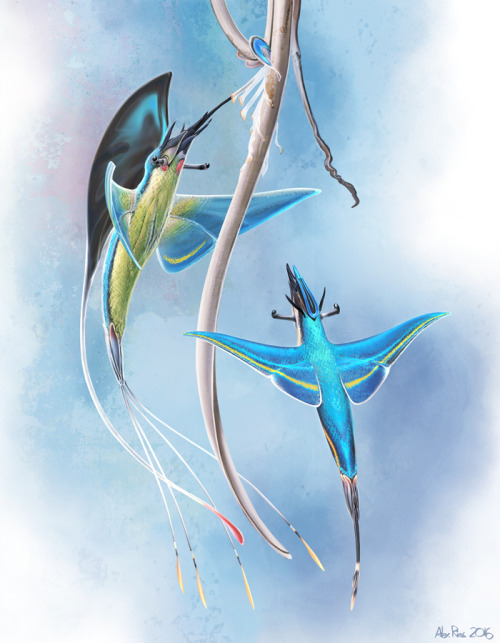
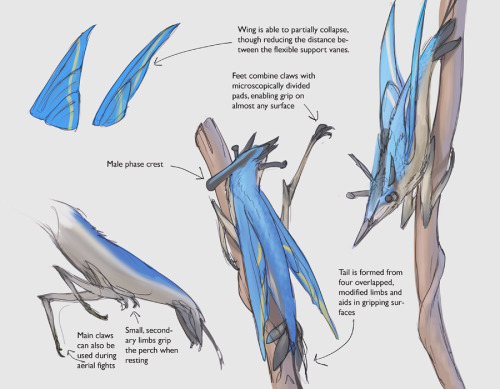
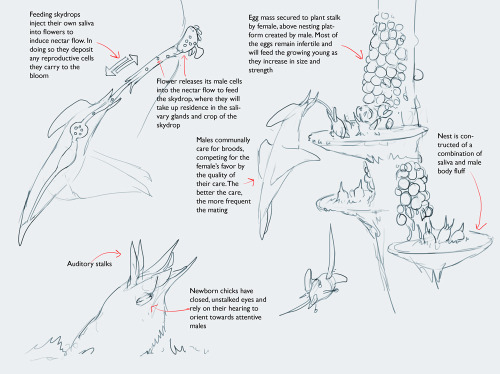
The Skydrops of Chriirah.
have you seen South Scrimshaw?
Hadn't even heard of it before your ask but it looks pretty cool! I love grounded-yet-whimsical parallel-biosphere stuff like this; reminds me of the old Morae River Project a bit! Gonna have to check it out soon, thanks for the rec!
It wrinkles my brain that Jupiter’s moon Europa has oceans that are sixty miles deep, while Earth’s oceans only reach seven miles deep at most. I’m willing to bet good money that there’s life in Europa’s oceans. Like five bucks. You hear me, NASA? I bet you five bucks that there’s life on Europa… Now that there’s money and reputation on the line, I bet they send a mission there real quick.
I suspect you're looking for Xenology, by Rob Freitas, Jr. It's a bit dated (by nearly half a century) but an invaluable resource nonetheless.
A few years ago, I found a link (from here?) to a website where some professor had published online, for free, his in-depth textbook on xenobiology.
I'm trying to find it again, because it was fascinating, but because it was just called something bland like "Xenobiology" or "Astrobiology", I simply can't find it by searching.
It discussed such concepts as defining life as negentropic systems, and coil-based musculature for flight.
Alien designs be like…
